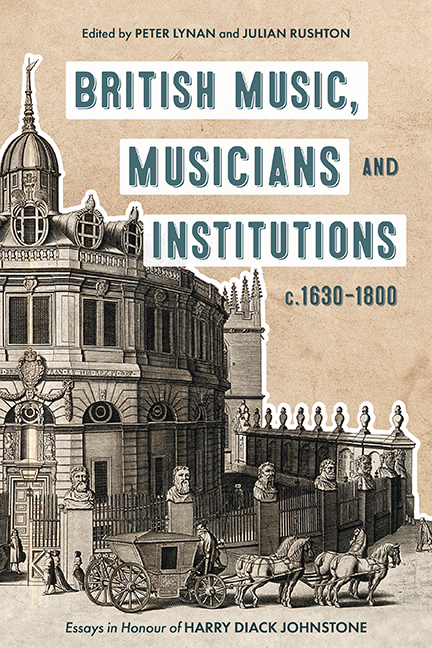Book contents
- Frontmatter
- Contents
- List of Illustrations
- List of Music Examples
- List of Contributors
- Acknowledgements
- List of Abbreviations
- Note to the Reader
- Introduction
- Part I Performers and Performance Style
- Part II Composers and Secular Institutions
- Part III Sacred Music and Institutions
- Part IV Dissemination: Copying, Printing, and Publishing
- Epilogue: Musica Britannica and the Eighteenth Century
- Harry Diack Johnstone: A Tribute
- Bibliography of the Publications of Harry Diack Johnstone
- Index
- Tabula Gratulatoria
11 - Precedents for the Symphony Anthem: British Library Additional Manuscript 31434 and the Court of Charles I
Published online by Cambridge University Press: 06 October 2022
- Frontmatter
- Contents
- List of Illustrations
- List of Music Examples
- List of Contributors
- Acknowledgements
- List of Abbreviations
- Note to the Reader
- Introduction
- Part I Performers and Performance Style
- Part II Composers and Secular Institutions
- Part III Sacred Music and Institutions
- Part IV Dissemination: Copying, Printing, and Publishing
- Epilogue: Musica Britannica and the Eighteenth Century
- Harry Diack Johnstone: A Tribute
- Bibliography of the Publications of Harry Diack Johnstone
- Index
- Tabula Gratulatoria
Summary
The story of the English Restoration symphony anthem is well known: Charles II took great pride in his chapel music; his tastes were formed while in exile in Paris; he knew the sort of music he liked, so his court musicians produced it for him; and on Sundays and holy days it was performed for him when he attended chapel. Some early Restoration Chapel Royal anthems still made use of the wind band as in pre-Commonwealth times, but it is the new-style symphony anthems for strings, by Henry Cooke and Pelham Humfrey in particular, that have come to epitomize the early Chapel Royal anthem. According to Thomas Tudway, it was King Charles II who ‘Order’d the Composers of his Chappell, to add Symphonys &c. w[i]th Instruments to their Anthems; and thereupon Establis[h]’d a select number of his private music, to play the Symphonys, & Ritornellos, w[hi]ch he had appointed’. On 7 September 1662 Samuel Pepys noted in his diary that he had heard ‘a most excellent Anthem (with Symphony's between)’, and a week later he stated, ‘To White-hall chapel, where sermon done and I heard Captain Cookes new Musique; this is the first day of having Vialls and other Instruments to play a Symphony between every verse of the Anthem; but the Musique more full than it was last Sunday, and very fine it is.’ The other famous diarist of the time, John Evelyn, was not such a fan and thought the music better suited to ‘a Tavern or Play-house than a Church’!
What follows does not seek to question the importance of musical developments at Whitehall in the early years of the Restoration. The re-establishing of the Chapel Royal and other court music groups in 1660, after the fifteen-year or more hiatus caused by the Civil War and Commonwealth, undoubtedly represents a fresh start. Even so, there may be a little more continuity to the symphony anthem tradition than has hitherto been realized, and this chapter seeks to suggest that there are precedents for the symphony anthem at the court of Charles I dating back to the late 1630s.
- Type
- Chapter
- Information
- British Music, Musicians and Institutions, c. 1630-1800Essays in Honour of Harry Diack Johnstone, pp. 199 - 222Publisher: Boydell & BrewerPrint publication year: 2022



